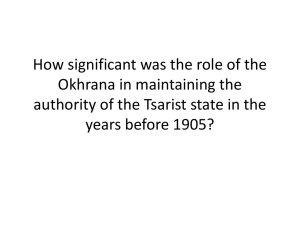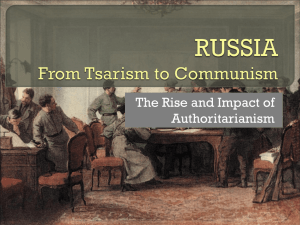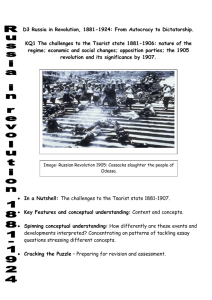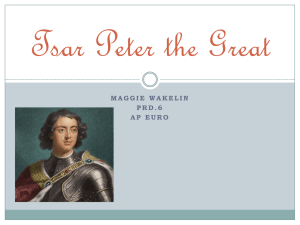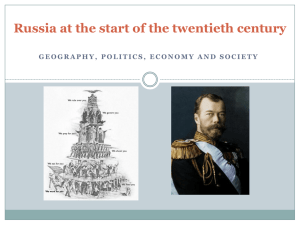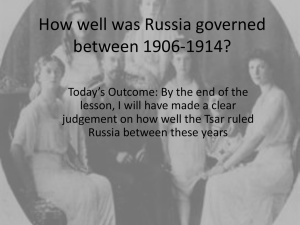File
advertisement
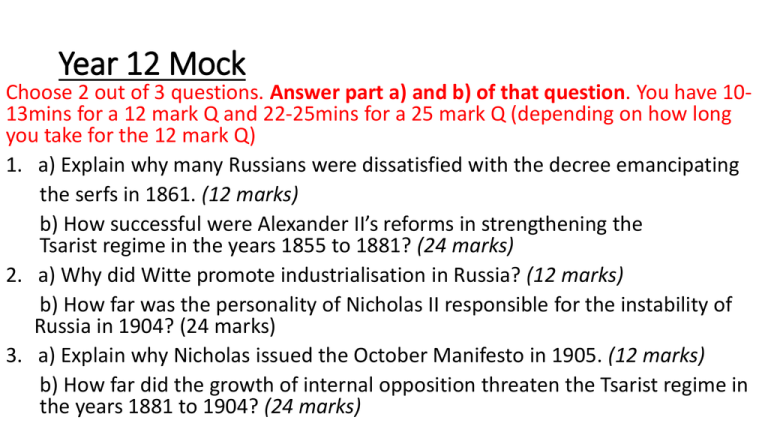
Year 12 Mock Choose 2 out of 3 questions. Answer part a) and b) of that question. You have 1013mins for a 12 mark Q and 22-25mins for a 25 mark Q (depending on how long you take for the 12 mark Q) 1. a) Explain why many Russians were dissatisfied with the decree emancipating the serfs in 1861. (12 marks) b) How successful were Alexander II’s reforms in strengthening the Tsarist regime in the years 1855 to 1881? (24 marks) 2. a) Why did Witte promote industrialisation in Russia? (12 marks) b) How far was the personality of Nicholas II responsible for the instability of Russia in 1904? (24 marks) 3. a) Explain why Nicholas issued the October Manifesto in 1905. (12 marks) b) How far did the growth of internal opposition threaten the Tsarist regime in the years 1881 to 1904? (24 marks) Num ber 1 2 3 4 5 6 7 8 9 10 11 12 13 Aspect of work Clearly structured work Clear focus and understanding of the demands of the question Appropriate evidence included Accurate, precise and detailed evidence included Explanation is relevant and may focus on reasons why or impact Explanation of reasons and impact is detailed, precise and appropriately linked to the question Analysis/assessment of how far the factor contributes to the questions Link between factors to show how they contribute to one another Link to wider implications these factors have Balance of argument Understanding of historical interpretations Explanation of most important/successful aspect Evaluation of most important/successful. Why is “x” more important/successful than “y” Grade boundaries • 54 - A • 46 - B • 38 - C • 30 - D If you got 6/12 or less, or 12/24 or less on a question then you will need to re-do that question on Thursday after school. If you got higher and you wish to re-do a question, then you can either join or re-do at home. Year 12 Mock Feedback – 12 mark Q’s • 3 points • Evidence (examples) to back up your ideas – detailed, accurate and precise for Level 4 • Explained and linked to the question • Highlight how each point links together • What are the implications of the issues you explain for Russia? • V. brief conclusion, most key point, but this can also highlight what this means for Russia Year 12 Mock Feedback – 24 mark Q’s • 3 points • Evidence (examples) to back up your ideas. The more detailed and precise you are, then the higher your marks will be • Explained and linked to the question • Highlight how each point links together • Assess each factor and say how far/much it relates to the Q – this Q prompts debate/argument • Balance of argument – understand what the Q is asking and include appropriate evidence, but equally argue the other side • What are the implications of the issues you explain for Russia? • Conclusion, most key point and why Year 12 Mock Feedback – Q1a 1. a) Explain why many Russians were dissatisfied with the decree emancipating the serfs in 1861. (12 marks) • WC – redemption payments over 49years, debt, tied to the land due to redemption payments and had to pay for land that they had previously had and, in some cases, was practically worthless • Aristocracy – Loss of land, influence/control, loss of work force, debts, unable to maintain previous lifestyle and begin to doubt the Tsar and his leadership Year 12 Mock Feedback – Q1b b) How successful were Alexander II’s reforms in strengthening the Tsarist regime in the years 1855 to 1881? (24 marks) Strengthened: • the Emancipation of the Serfs in 1861 heralded a period of reform and gave unprecedented freedoms to over 90 million people creating greater loyalty • reform of the army, local government, the military, the Church, education and a relaxation of censorship could be regarded as strengthening and successful. They were designed to modernise Russia and strengthen the regime in the wake of defeat in the Crimean War and increasing awareness of the industrial development taking place in some European countries. Negatively, these could encourage freedom of thought and meetings of reactionary and revolutionary groups. The military also lost the Russo-Turkish War in 1877-78 • the Zemstva and town dumas harnessed the energies of the professionals and intelligentsia in strengthening tsarist government and promoting welfare and economic growth • industrial growth was stimulated by the reform of the economy and government sponsorship and helped strengthen the economic basis of the regime • reforms pacified many of those who were seeking change, including Westernisers and Liberal intellectuals, who worked with the Tsardom • after some sporadic outbreaks of violence in the early 1860s, there was little evidence of direct opposition that threatened the stability of the regime • the response of peasants in the 1870s to Populist agitators suggest most peasants were satisfied by reform. The Russian Orthodox Church was pivotal in ensuring the loyalty of most subjects to the tsar, whom they considered to be divinely appointed. This strengthened the state. Weakened: • the particular terms of the Emancipation Edict came as a disappointment to many, including peasants. There was resentment over Redemption payments, the pressure of a rising population and land hunger made the situation worse. Outbreaks of violence were widespread • • the nobility resented a loss of cheap labour following emancipation. Many were in debt before the Emancipation Edict, having mortgaged their serfs. The long term nature of compensation in the form of redemption payments caused further economic difficulty to this group. This limited their ability to invest in economic modernisation • • education for most Russians remained limited, despite some liberalisation of universities. In agriculture, education had little impact. Ideas about agricultural modernisation did not spread and the mir remained un-enterprising in their management of villages. The regime’s economic basis was not as strong as it appeared • • the introduction of Zemstva and town dumas did not satisfy those seeking a national political voice, and indeed their work at a local level fuelled demands for greater involvement in national government • • legal reforms such as more open trials and the introduction of trial by jury, while significant, still did not address “political” crimes. Government officials retained wide powers. Incidents such as the Vera Zasulich case undermined the credibility of the regime • • the pace of reform slowed in the mid-1860s, particularly after the Polish Revolt of 1863 and repeated attempts on the tsar’s life. Reliance on repression suggests the regime was not strong Year 12 Mock Feedback – Q2a 2. a) Why did Witte promote industrialisation in Russia? (12 marks) • By the 1880s Russia was still essentially an agricultural, peasant-based society. There had been a boom in railway building and developments in the iron and oil industries since 1861, but most industry was small-scale. Many conservatives, but also some radicals, opposed industrialisation either as a potentially dangerous disruptive force or else because it was not “traditionally Russian”. Because peasants were still largely tied to the land, it was not easy to create an industrial workforce, nor was their sufficient capital. • The change in official attitudes was largely due to Witte, Minister of Finance 1892–1903. He had a business and railway administration background and had retained his links with industry, and therefore was in favour of promoting industrialisation. • Witte was afraid that without industrialisation, Russia would fall further behind the more advanced West. An unindustrialised Russia might even be seen as an area for colonial exploitation by other Great Powers. • Witte’s views were famously outlined in his 1899 memorandum on Industrial Development, arguing that Russia must industrialise through attracting foreign investment and direct Government intervention if Russia were to develop as a Great Power and maintain and develop its status. • Witte believed that an industrialised, more powerful Russia would strengthen the autocracy Year 12 Mock Feedback – Q2b b) How far was the personality of Nicholas II responsible for the instability of Russia in 1904? (24 marks) • Nicholas’ actions – Land Captains, Russification, anti-Semitism (pogroms), Zemstva changes (or lack of them) etc • Population increases – unstable social structure unable to deal with increase in population, 7m to 28m people in urban areas • Rural problems caused by industrialisation – famine, lack of work force, inefficient methods • Urban problems – overcrowding, poor working conditions, shared housing, lack of food and consumable materials/wealth • Autocratic structure and beliefs – tsar as unquestioned leader, refuses to listen to others (link to Zemstva changes and Liberal purge of 1900) Year 12 Mock Feedback – Q3a 3. a) Explain why Nicholas issued the October Manifesto in 1905. (12 marks) • the tsarist regime had faced revolution in 1905, the Bloody Sunday Massacre, failure in the war against Japan and in the long term appalling living standards and a lack of constitutional reform had created the revolutionary situation • Nicholas had refused to negotiate but by October 1905 the situation was dreadful. The collapse of the Russian fleet against Japan, naval mutinies and continued strikes meant that the Tsar had to make concessions in order to avoid revolution • Sergei Witte was recalled by the Tsar, drafted the October Manifesto and persuaded Nicholas to sign it • the October Manifesto granted some moderate reform and was able to divide the opposition enabling the tsarist regime to survive the attempted revolution. Year 12 Mock Feedback – Q3b b) How far did the growth of internal opposition threaten the Tsarist regime in the years 1881 to 1904? (24 marks) Factors which suggest the growth of internal opposition did threaten the tsarist regime in the years 1881 to 1904 might include: • some political revolutionaries attempted to destabilise the regime through terrorist activity in the 1880s, notably splinter groups of the populists. Lenin’s own brother was executed following an assassination attempt on the Tsar in 1887 • Marxist works were smuggled into Russia in the 1880s and the growth of towns in the 1890s provided crowded conditions in which illegal pamphlets could more easily be circulated. By 1898 the Marxists were sufficiently organised to form the RSDLP (SDs) and in 1902 Lenin published his pamphlet ‘What is to be Done?’ • opposition to the regime was not completely eradicated, but was driven underground. Revolutionary leaders such as Georg Plenkhanov were exiled abroad, where they continued to raise awareness of their cause. Many would return later • famine in 1891-2 refocused attention on the plight of the peasantry and Populist ideas re-emerged around the turn of the century among university students. The formation in 1901 of the Social Revolutionary Party by Victor Chernov marked a turning point by bringing together populist opinion within one umbrella group. • Liberal ideas persisted among the intelligentsia and in the late 1890s there was a resurgence of liberal sentiment. Dinner parties provided a forum for a growing class of educated professionals and business people to share ideas about democracy. Factors supporting the case that the growth of internal opposition did not threaten the tsarist regime might include: • the harsh treatment of his father’s killers in 1881 set the tone for a period of reaction. Influenced by conservatives at Court, Tsar Alexander III aimed to strengthen the Orthodox church and the position of the nobility in order to secure the autocracy against real and potential opposition • Alexander III clamped down heavily on opposition groups by increasing repression after 1881. A Statute of State Security made provision for arbitrary arrest and the repeated renewal of this legislation transformed Russia effectively into a police state. The activity of the secret police and measures preventing the formation of even benign student groups meant opportunities for overt opposition were extremely limited • in rural areas, the population was kept firmly under control by Land Captains, introduced in 1889/90, and government appointed provincial governors ensured stability. The 1890 Zemstva Act and the 1892 Municipal Government Act reduced the power of the zemstva by increasing government control over them and restricting participation in zemstva elections • any opposition that existed was tiny, and exerted little influence on the bulk of the population who remained overwhelmingly loyal to the Tsarist regime.
